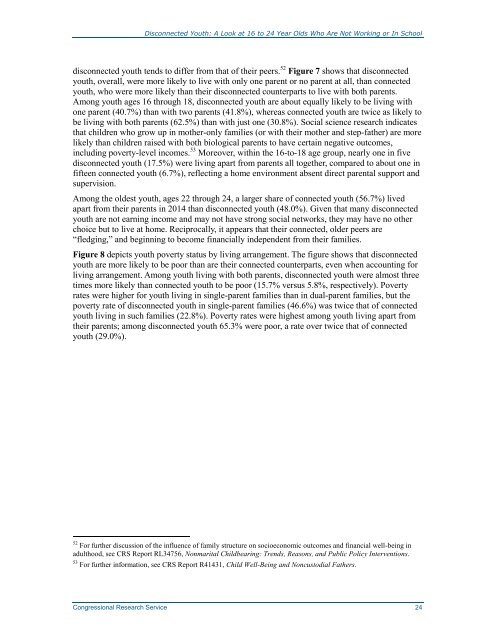Opportunity Youth: Disenfranchised Young People
Opportunity Youth: Disenfranchised Young People
Opportunity Youth: Disenfranchised Young People
You also want an ePaper? Increase the reach of your titles
YUMPU automatically turns print PDFs into web optimized ePapers that Google loves.
Disconnected <strong>Youth</strong>: A Look at 16 to 24 Year Olds Who Are Not Working or In School<br />
disconnected youth tends to differ from that of their peers. 52 Figure 7 shows that disconnected<br />
youth, overall, were more likely to live with only one parent or no parent at all, than connected<br />
youth, who were more likely than their disconnected counterparts to live with both parents.<br />
Among youth ages 16 through 18, disconnected youth are about equally likely to be living with<br />
one parent (40.7%) than with two parents (41.8%), whereas connected youth are twice as likely to<br />
be living with both parents (62.5%) than with just one (30.8%). Social science research indicates<br />
that children who grow up in mother-only families (or with their mother and step-father) are more<br />
likely than children raised with both biological parents to have certain negative outcomes,<br />
including poverty-level incomes. 53 Moreover, within the 16-to-18 age group, nearly one in five<br />
disconnected youth (17.5%) were living apart from parents all together, compared to about one in<br />
fifteen connected youth (6.7%), reflecting a home environment absent direct parental support and<br />
supervision.<br />
Among the oldest youth, ages 22 through 24, a larger share of connected youth (56.7%) lived<br />
apart from their parents in 2014 than disconnected youth (48.0%). Given that many disconnected<br />
youth are not earning income and may not have strong social networks, they may have no other<br />
choice but to live at home. Reciprocally, it appears that their connected, older peers are<br />
“fledging,” and beginning to become financially independent from their families.<br />
Figure 8 depicts youth poverty status by living arrangement. The figure shows that disconnected<br />
youth are more likely to be poor than are their connected counterparts, even when accounting for<br />
living arrangement. Among youth living with both parents, disconnected youth were almost three<br />
times more likely than connected youth to be poor (15.7% versus 5.8%, respectively). Poverty<br />
rates were higher for youth living in single-parent families than in dual-parent families, but the<br />
poverty rate of disconnected youth in single-parent families (46.6%) was twice that of connected<br />
youth living in such families (22.8%). Poverty rates were highest among youth living apart from<br />
their parents; among disconnected youth 65.3% were poor, a rate over twice that of connected<br />
youth (29.0%).<br />
52 For further discussion of the influence of family structure on socioeconomic outcomes and financial well-being in<br />
adulthood, see CRS Report RL34756, Nonmarital Childbearing: Trends, Reasons, and Public Policy Interventions.<br />
53 For further information, see CRS Report R41431, Child Well-Being and Noncustodial Fathers.<br />
Congressional Research Service 24

















